There are over 1,000 different cattle breeds in the world today. In America, many people mistakenly assume the cattle currently in the United States mostly originated here.
The truth is that some of the most popular cattle in this country come from overseas, especially Scotland. There are several Scottish cattle breeds that originated there and are now thriving across the world today.
Table of Contents
Names of Cow Breeds in Scotland
Scotland has several different breeds of cattle, including the Highland, Shorthorn, Ayrshire, Angus, Galloway, and Luing. Cows are often referred to as coos in Scotland.

What Are the Shaggy Cows in Scotland Called?
When people refer to shaggy or fluffy Scotland cows, they almost always refer to Highland cattle. Highland cows are extra friendly and have adorable long, wavy hair that adds to their cuteness.
Often, the hair on a Highland cow’s face will fall over its eyes. Their long-haired coats help keep them warm in colder climate areas like Scotland.
In Scotland, farmers sometimes refer to Highland cows as heilan coos. This breed remains exceptionally popular in Scotland and continues to grow in popularity in the United States also.
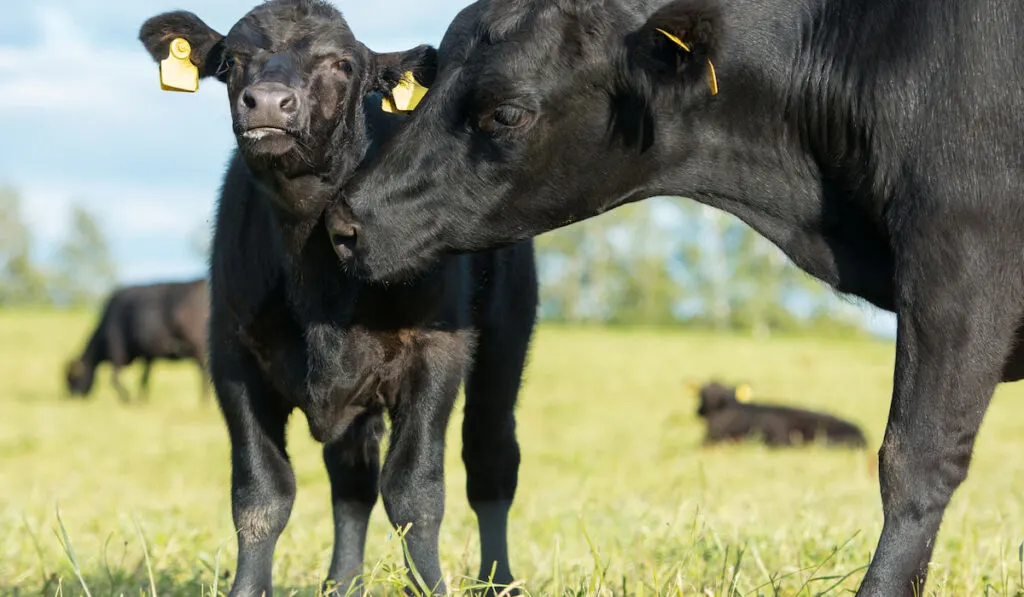
Which Black Breed of Cattle Originated in Scotland?
There are a few different Scottish cattle breeds that feature black cows, but the Angus is likely the Scottish cattle breed most people talk about.
Often referred to as the Aberdeen Angus, the Angus breed features solid black cows that produce exceptionally marbled meat that cattle owners and consumers prefer.
The Galloway cattle breed also originated in Scotland and features mostly black cows. Shetland cattle are also a Scottish breed that often produces black cows. They are so rare most people have never seen one before.
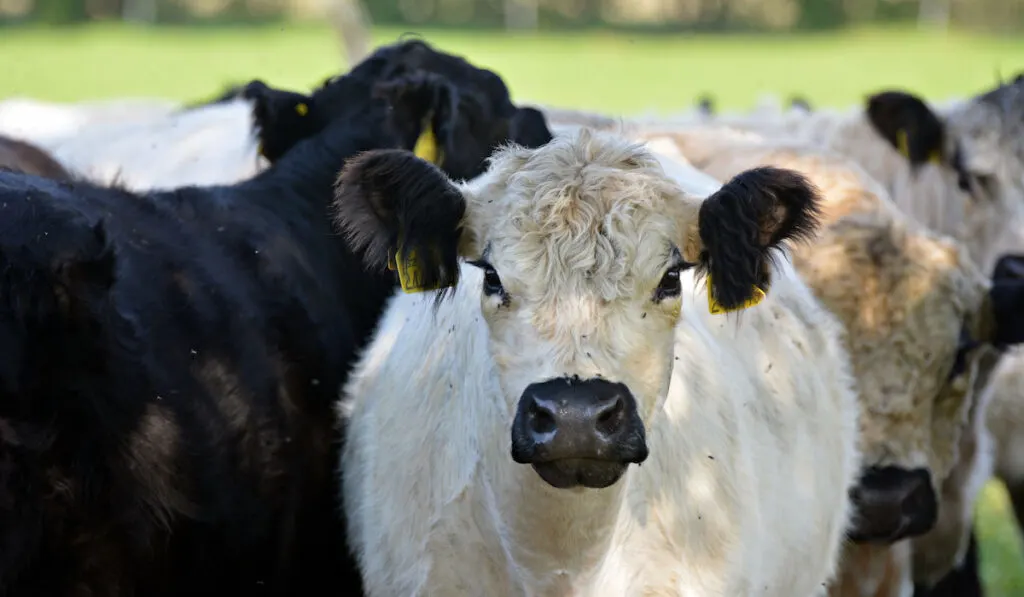
Which Scottish Cattle Breeds Have White Cows?
There are a couple of Scottish Cattle breeds that produce cows with white coats. These include Galloway and Shorthorn. White Shorthorns are classified as belonging to a different breed in some countries.
Galloway cattle are sometimes white, although it is not a very common color. White Galloways can be a solid white or white park, which is white with black ears and noses.
Ayrshire cattle are red with white markings on their coats. Most of the other Scottish cattle breeds do not produce white cows.
What Breeds of Cattle Came from Scotland?
Several Scottish cattle breeds roam pastures around the world, and you may even be familiar with many of them. Many cattle owners in Scotland spent decades, even centuries, cultivating these breeds leading to their longevity.
The following cattle breeds all originated in Scotland.
Shorthorn

Average Weight: 1,700-2,200 pounds
Beef or Dairy: Both
Coat Color: Red, white, or Roan
Coat Length: Medium, Wavy
The Shorthorn is a beef cattle breed that originated in Scotland around the 18th century. This cattle breed gained popularity across America thanks to its calm nature and hardiness, as well as its exceptional milk and meat production.
It is difficult for cattle owners to find a dual-purpose cow, so this breed fits the bill for many cattle owners across the world. Shorthorn cattle do well in various climates and rarely get sick, which adds to their appeal.
Shorthorn cattle also thrive in all parts of the country, and it is very common to see them grazing in pastures. Many farmers enjoy raising them since they tend to be friendly and are not prone to disease.
Cattle in this breed are either white, red, or roan-colored. They have medium-length wavy hair that helps keep them warm in the winter but does not seem to overheat them in the warmer months.
They have short horns, hence their name. However, many ranchers poll or remove the horns when these cows are very young. Horn removal helps keep ranchers and other cows safe from the unnecessary harm that horns can cause; however, it does leave the cows slightly more vulnerable to predators.
Polled Shorthorn cattle, born without horns, is a breed developed in the United States from the Shorthorn cattle from Scotland. When cows are born without horns, cattle ranchers do not have to spend time and money removing the horns from each calf.
Although Polled Shorthorns are technically a United States breed, their origins are still Scottish. The original Shorthorn cattle breed also helped create other cattle breeds, including the Santa Gertrudis and the Belmont Red.
Whitebred Shorthorn
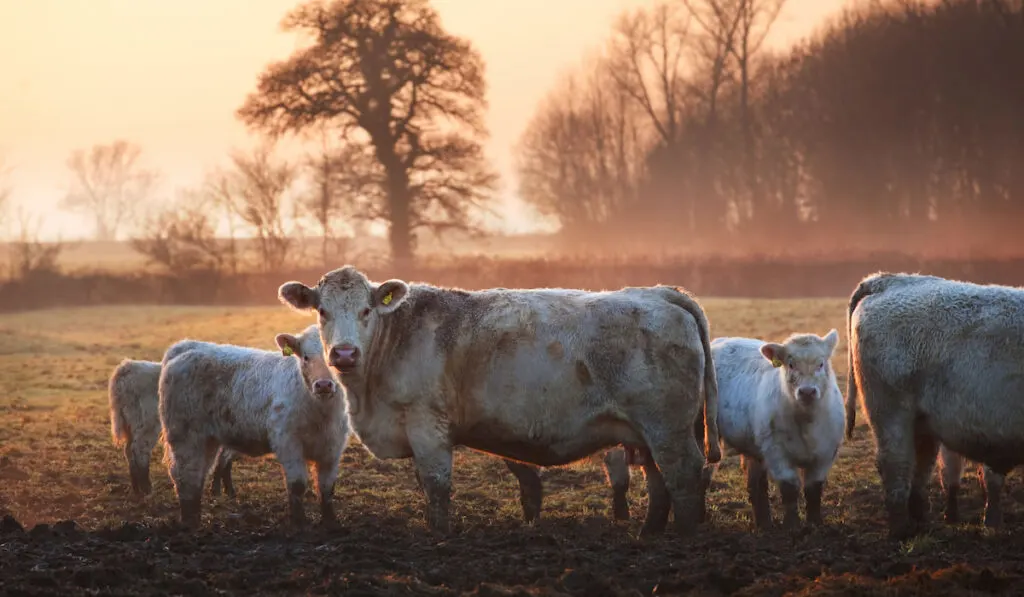
Average Weight: 1,700-2,200 pounds
Beef or Dairy: Both
Coat Color: White
Coat Length: Medium, Wavy
Though most people believe these cattle are shorthorn cattle that cattle enthusiasts crossbred to produce only white cattle. However, the Whitebred Shorthorn is a Scottish cattle breed that is a separate breed from shorthorns.
The consensus is that farmers refined this breed to assist in the production of blue-grey cattle, a hybrid cow discussed in the next section. Regardless of how this breed came to be, it remains a lasting Scottish cattle breed, although its future is in question.
Whitebred Shorthorn cattle are entirely white, although they appear cream-colored. They have medium-length wavy hair and short horns that are also often polled when they are young.
Whitebred Shorthorn cows are often used to produce Blue Grey cattle, a hybrid breed that once was very popular. Breeding a Whitebred Shorthorn bull with a black Galloway cow produces cattle with blue-grey or blue-roan coats of hair.
Today, the Rare Breeds Survival Trust watchlist lists the Whitebred Shorthorn as an ‘at risk’ cattle breed. Although the breed’s survival is ‘at risk’, it in no way hinders the many positive qualities of this breed.
Blue Grey Cattle
Average Weight: 1,700-2,200*
Beef or Dairy: Beef
Coat Color: Blue roan
Coat Length: Medium, Curly
*Based on the average weight of contributing breeds.
Blue Grey cattle are classified as a separate breed, although they are technically a hybrid between a Whitehorn bull and a black Galloway cow. Both cattle breeds originated in Scotland, along with the Blue Grey breed.
The cows in this breed are visually beautiful and were once very popular thanks to their unique appearance. Blue Grey cattle have stunning roan-colored coats with intermixed white and black hairs that appear blue or grey.
These cattle are slow growers, so they are not considered ideal for cattle owners looking solely for meat-production cows. Despite their slow growth rate, they are still great additions to any cattle operation.
This ideal mixing of breeds creates a healthy, stocky, and hardy cow. Cattle owners raise Blue Grey cows for both their beef and milk production.
Today, authentic Blue Grey cattle are rare, as many cattle owners across the world opt for fast-growing cattle like the Angus or Highland breeds. The future of this breed plays a massive role in the future of Whitebred Shorthorns, as many ranchers raise them with the intention of producing this hybrid breed.
Highland
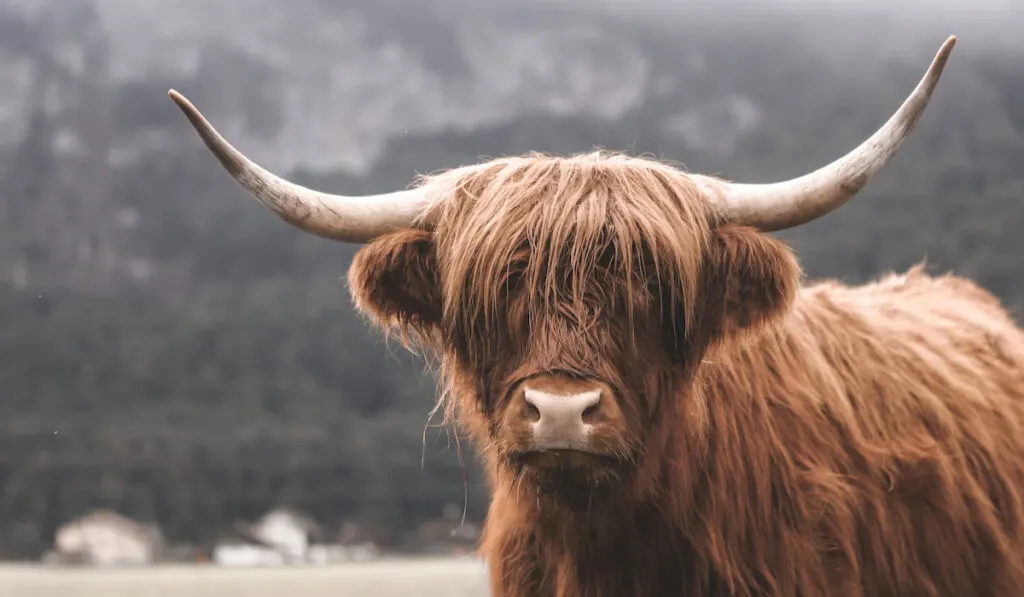
Average Weight: 990-1,430 pounds
Beef or Dairy: Beef
Coat Color: Red, brown, yellow, silver grey, brindle-dun, black
Coat Length: Long, wavy
Highland cattle are utterly adorable beef cows with long, thick coats of hair and prominent horns. They are extremely friendly cows with either red, black, brindle, white or tan skin color.
Thanks to their long shaggy coats of hair, Scottish highland cattle do well in cold climates. However, they will struggle in extremely hot regions of the United States if they cannot find adequate shade.
Their long hair provides insulation, allowing them to survive in areas other cows would not thrive in. Somehow, the added insulation makes the meat these cows produce much leaner and lower in cholesterol than other breeds.
Highland cattle make great farm animals due to their calm demeanors and hardiness. Cattle enthusiasts brought Highland cattle to America sometime during the 1890s, and the breed has remained a famous cattle breed in the country ever since.
The Highland cattle breed was the premier registered cattle breed in the entire world. This breed has stood the test of time, and today, even though they are not as popular as Angus cows, they are still well-known and desired in many parts of the world.
Luing
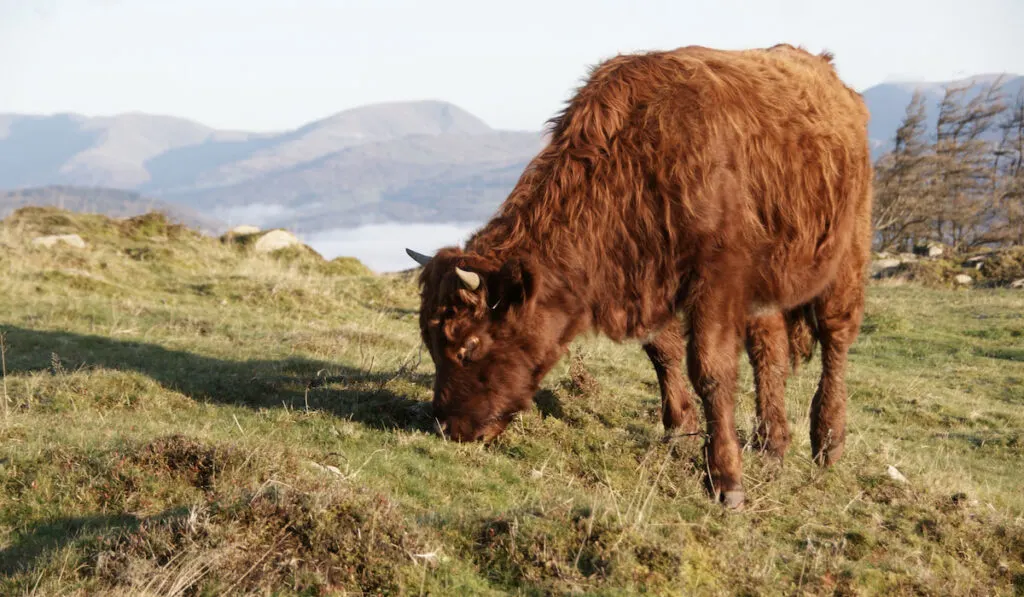
Average Weight: 1,100-2,100 pounds
Beef or Dairy: Beef
Coat Color: Red or Dun
Coat Length: Medium
In 1947, a Scottish family began creating what would eventually become a whole new breed of cattle called Luing cattle. Cattle enthusiasts in Scotland developed this new breed by breeding Shorthorn cattle with Highland cows, then breeding those offspring back to Shorthorns.
While it may have seemed like a long shot to some, the Cadzow family was on to something, and their project paid off. The Luing cattle breed combined the best aspects of two great Scottish cattle breeds and produced a solid, lasting cattle breed.
While most Luing cows still live in the United Kingdom, some have made their way to other countries like Canada and New Zealand. Luing cattle ranchers all seem to agree that the breed produces hardy cows with marbled meat.
Luing cows have short, reddish-brown hair, and they do not have horns. Like their predecessors, Luing cows are friendly, strong, and extremely resilient.
Their ability to adapt has led to this breed’s survival till today, although these cows are now considered somewhat rare. As of December 2021, there are about 7,014 registered Luing cows roaming the pastures of Scotland and the United Kingdom.
Galloway
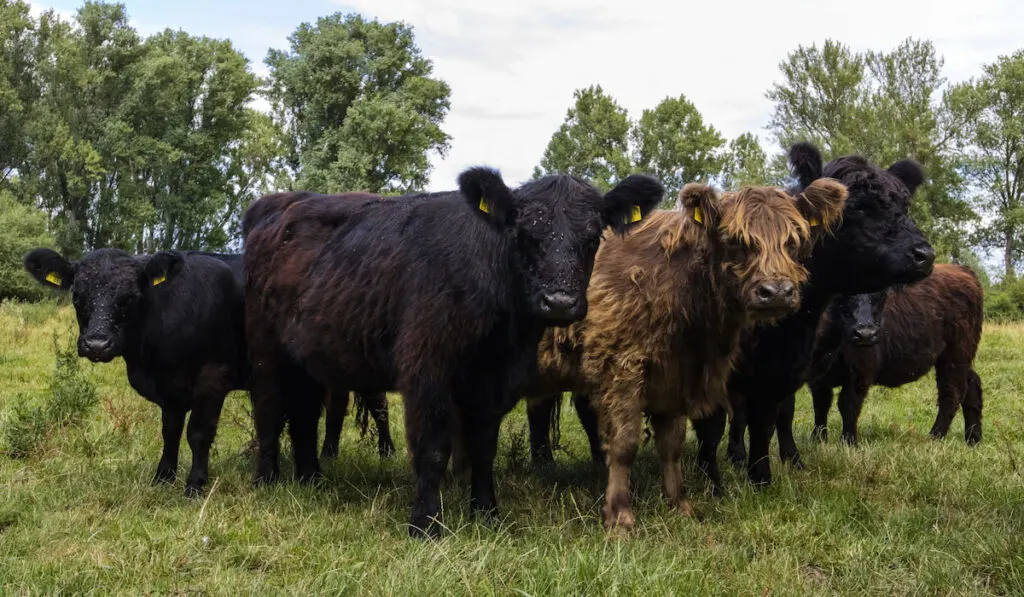
Average Weight: 1,800-2,200 pounds
Beef or Dairy: Beef
Coat Color: Black, red, dun, white, riggit-patterned
Coat Length: Medium-length, thick, and wavy
The Galloway cattle breed originated in the Scottish region of Galloway in the 17th century and made its way to North America in 1853. The breed took a bit to catch on, but by 1911, there were 35,000 Galloway cows registered in the United States.
These beef cows are almost always solid black, but sometimes they are red, dun, and white in rare instances. They have medium-length, wavy hair that is noticeably thick, and they naturally do not have horns.
Many Galloway cattle owners describe these cows as friendly and easy to handle. Cows in this breed are medium-sized and have thick coats of curly hair, which helps keep them warm in colder climates.
Most cattle owners raise Galloway cows for their meat, and their thick coats of hair make them extremely popular on farms in colder regions. Galloway cows make excellent mothers, live long lives, and produce high-quality meat.
The breed’s popularity seemed to waiver during the 1990s, but things seem to be improving. Today, Galloway cows are doing well. As of 2022, there are about 26,800 Galloways roaming the world.
Belted Galloway
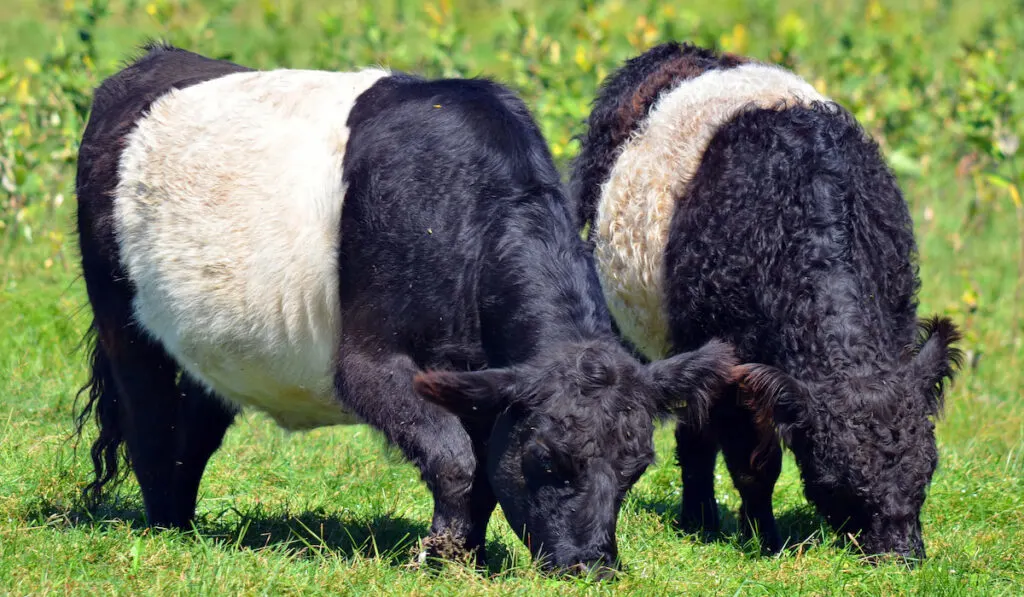
Average Weight: 1,000-2,300 pounds
Beef or Dairy: Beef
Coat Color: Black and white
Coat Length: Medium-length, thick, and wavy
The Belted Galloway breed is another Scottish cattle breed that is moderately popular in the United States. The Belted Galloway is a descendant of the Galloway, so they appear very similar, apart from the noticeable white belt of hair that often covers their midsection.
At some point in time, cattle ranchers crossed Galloway cattle with Lakenvelder cows, producing the Belted Galloway breed. Lakenvelder cows have a similar white belt across their bellies, while the Galloways were solid black.
The result was a whole new breed of cattle that had medium-length wavy hair along with white belts of hair around their abdominal area—the Belted Galloway.
The white belts on these cows vary in size, and the cow’s primary color is usually black, although red or dun-colored hair is possible.
Belted Galloways naturally do not grow horns and are rather friendly cows that do well on most farms. Most cattle ranchers raise them for their meat, which tends to have high marbling and is regarded for its tenderness.
Many Belted Galloway breeders refer to them as Belties. To be honest, they are some of the cutest cows on this list, apart from Highlands, of course. Their wavy hair and the stark white belt of hair around their bellies make them undeniably adorable.
Ayrshire
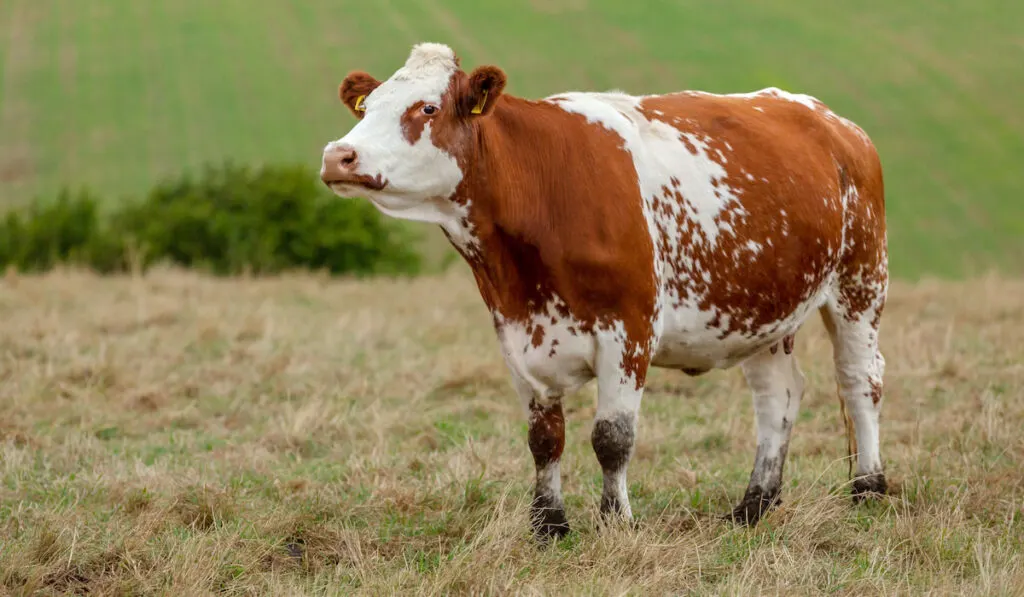
Average Weight: 1200 pounds
Beef or Dairy: Dairy
Coat Color: Red and White
Coat Length: Short
The Ayrshire cattle breed originated in Scotland sometime before the 1800s and became an official cattle breed in 1814. The breed gained popularity and made its way to the United States and other countries around 1822.
Cattle owners raise Ayrshire cattle primarily for their milk, as they can produce up to 20,000 pounds of milk annually. Full-blooded cows in this dairy breed are always red and white, although their specific shade of red varies from cow to cow.
Ayrshire cattle are famous among dairy farmers thanks to their ability to withstand harsh climates and their friendly nature. Many cow milk buyers swear by their opinion that Ayrshire cattle milk is superior to other dairy breeds.
Ayrshire cows are usually born with horns, but most cattle handlers de-horn them at young ages since their horns can reach up to a foot long. Many ranchers do not see the need for such long horns, and by removing them, they can more easily handle and care for these cows.
This dairy cow breed is not as popular around the world as it once was, but thanks to its many positive qualities, it is still in existence.
Angus (Aberdeen Angus)

Average Weight: 1400-2200 pounds
Beef or Dairy: Beef
Coat Color: Black or red
Coat Length: Short
The Angus cattle breed is a cattle breed that most people have probably heard of before, although they are likely unaware of its Scottish history. Angus cows originated in Scotland. It has been in existence since the 16th century and became an official breed in 1835.
In Scotland, many people refer to them as Aberdeen Angus cows, Angus doddies, or hummlies. The Angus cattle breed is naturally resilient due to the region’s cold winters and sometimes harsh climate.
During the late 1800s, Scotland exported many cows in this breed to various countries, and cattle ranchers across the world took note of their favorable characteristics. Over the next century, Angus cattle grew in popularity worldwide.
Cows in the Angus breed are strong, muscular, and hardy animals that can thrive even in harsh climates. They grow quickly, make excellent mothers, and are very adaptable.
Angus cows are naturally polled, which means they do not have horns. These cattle are typically solid black or solid red, although, in America, we classify red Angus cows as a separate breed.
Most cattle owners raise Angus cows for beef production. In America and many other countries, many beef lovers consider Angus beef superior to other varieties of beef. Angus cows tend to sell for more money on average than other cow breeds, especially in America.
Red Angus
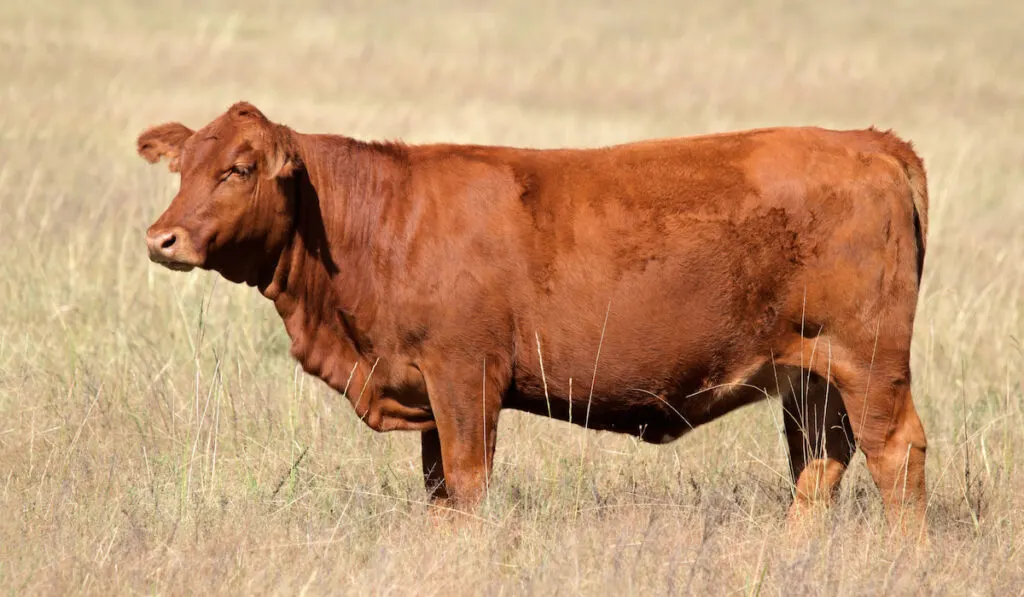
Average Weight: 1400-2000 pounds
Beef or Dairy: Beef
Coat Color: Red/Reddish Brown
Coat Length: Short
The Red Angus cattle breed is simply Angus cattle that are solid red instead of solid black. In some countries, including the U.S., many classify Red Angus as a different breed from Angus cattle.
The Red Angus breed has had its breed association in the U.S. since 1917; ranchers cannot register Angus cows with red coats as Angus cows. Apart from their color, there is no difference between red and black Angus cattle.
Like their counterpart, Red Angus cows are naturally polled and do not have horns. Cattle owners raise these cows primarily for their beef on many farms across the country and the world.
Depending on who you ask, some cattle owners believe that Red Angus cows are slightly superior to solid black Angus cattle, while others believe the exact opposite. The truth is both breeds consist of high-quality cows that produce highly sought-after meat.
Today, Red Angus cows are growing in popularity now that many people have come to recognize them as an equal or even superior breed to Angus cattle. In many countries, the number of Red Angus cattle is closely catching up to that of black Angus cows.
Shetland
Average Weight: 770-1,300 pounds
Beef or Dairy: Beef
Coat Color: Black/white, red/white, dun/grey
Coat Length: Short
The Shetland cattle breed also hails from Scotland, and many refer to them as Shetland kye. This breed dates to the 1800s before it was an official cattle breed. However, it almost became completely extinct in the early 1900s.
The breed has survived thanks to the resilience of several determined cattle owners over the years. But more work remains to be done as the number of living Shetland cows remains dangerously low.
Surprisingly, while this breed is not as popular as others, people typically consider their meat more healthy than other beef breeds.
This breed features small-sized cattle that naturally grow horns. Their hair is short and typically black with white spots, although some cows may have grey or reddish-colored hair instead.
Shetland cows typically have little to no issues calving, and thanks to their small stature, they are ideal for smaller farm operations. Most ranchers raise Shetland cattle for beef production, and the meat is said to contain tons of nutrients and is low in trans-fat.
This breed is not as popular or common in the United States, but you can find them in the Shetland Islands, a region in Scotland. Today, unfortunately, there are only about 800 registered Shetland cows in the United Kingdom.
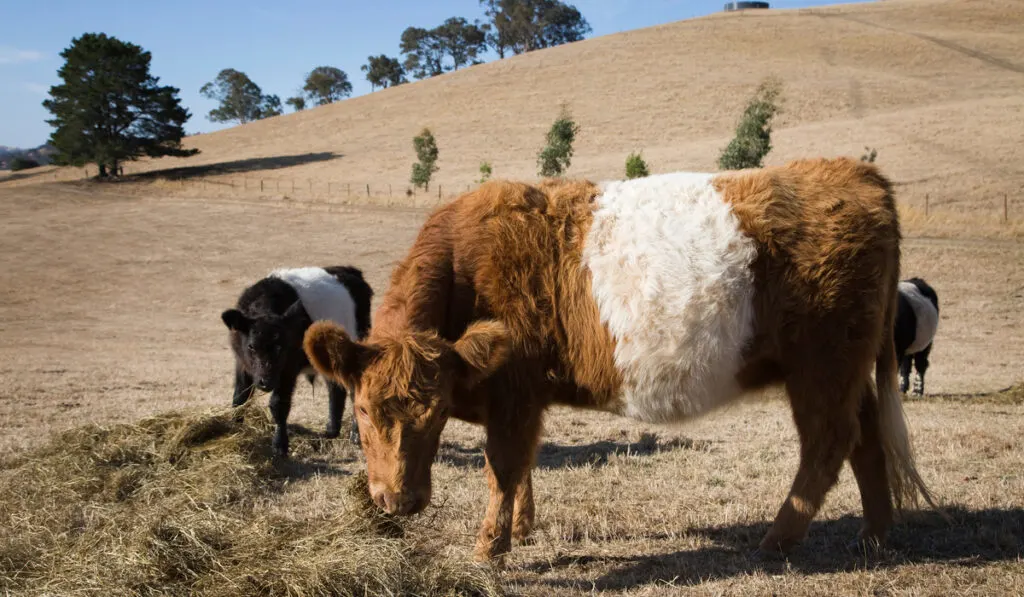
What is the Riggit Pattern in Scottish Galloway Cows?
In Scotland, riggit is a term used to describe a color pattern on some Galloway cattle. While most Galloway cows are solid-colored or have belts of white, some possess a unique riggit color pattern.
The riggit pattern refers to a white stripe that runs down the cow’s back. Apart from the white stripe, the rest of the coat is mostly solid black, red, brown, dun, or bluish-grey.
Often, these cows have specific areas with intermixed white hairs on their body. Some people may mistake this for a roaning pattern; however, the white stripe on their backs classifies it as riggit instead.
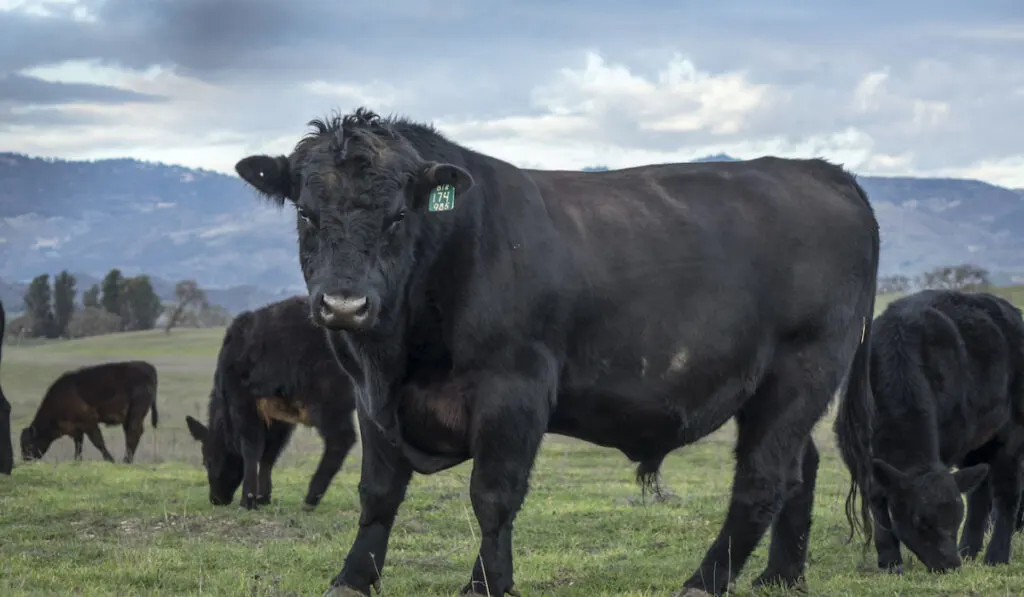
Which Scottish Cattle Breed is the Most Popular?
While Highland cows are gaining popularity due to their adorable fluffiness, the Angus cattle breed is by far the most famous Scottish cattle breed. Angus cows are not only hardy, but they also produce some extremely popular beef.
Cattle owners worldwide raise Angus cattle specifically for meat production because Angus beef naturally has a lot of marbling. Over the years, Angus beef has grown in popularity at grocery stores and restaurants, which has trickled down to the farm and sale barns.
Highland cows are also getting recognition, as social media sites have helped introduce their adorable faces to the world.
Highland cows may see an even more significant uptick in popularity over the next several years, and many breeders are offering miniature Highland cows that smaller backyard farms can handle.
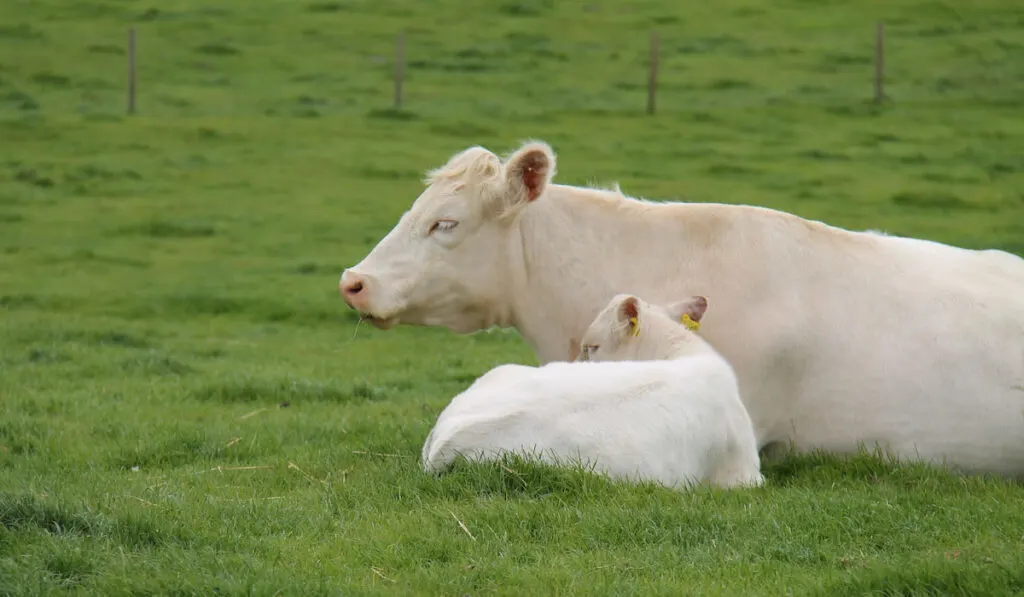
Which Scottish Cattle Breeds are Rarest?
The Whitebred Shorthorn, as well as the Shetland cattle breeds, are on the Rare Breeds Survival Trust watch list. These two breeds are the rarest Scottish Cattle breeds on this list and their survival in the years to come is in jeopardy.
Just because they are on the rare list does not mean either breed is lacking in quality. They are both tried and true Scottish cattle breeds, but the fact is, there are over 1,000 cow breeds across the world that they have to compete with.
If the desire for Blue Grey cows grows over the next several years, that will also create a need for more Whitebred Shorthorn cattle. Shetland cows have a lot to overcome, but with the right help, their breed can survive and become more prevalent than it currently is.
Final Thoughts
Many of the cattle breeds we know today in the United States originated in Scotland many years ago. The same cows that grew in popularity there are still seeing success in today’s bovine world.
It is undeniable that Scotland must know some secret formula for growing and cultivating lasting cattle breeds. All of these cattle breeds feature strong animals with calm demeanors and hardy dispositions.
Resources:
I used my knowledge of cattle and these sources to craft this article.
- https: //afs.ca.uky.edu/livestock/beef/breeds/scottish-highland
- https://www.tastingtable.com/1048293/red-angus-beef-vs-black-angus-whats-the-difference/
- https://en.wikipedia.org/wiki/Highland_cattle
- https://www.beefshorthorn.org/breed-characteristics
- https://www.roysfarm.com/shorthorn-cattle/
- https://www.whitebredshorthorn.com/about-the-breed
- https://en.wikipedia.org/wiki/Blue_Grey_cattle
- https://en.wikipedia.org/wiki/Luing_cattle
- https://en.wikipedia.org/wiki/Lakenvelder_cattle
- https://en.wikipedia.org/wiki/Belted_Galloway
- https://en.wikipedia.org/wiki/Galloway_cattle
- https://en.wikipedia.org/wiki/Ayrshire_cattle
- http://afs.okstate.edu/breeds/cattle/angus
- https://en.wikipedia.org/wiki/Aberdeen_Angus
- https://en.wikipedia.org/wiki/Shetland
- https://luingcattlesociety.co.uk/
- http://afs.okstate.edu/breeds/cattle/galloway/index.html/
- https://en.wikipedia.org/wiki/Shetland_cattle
- https://www.travelawaits.com/2486039/highland-cattle-scotland–majestic-cows/
- https://www.aberdeen-angus.co.uk/the-breed/
- https://luingcattlesociety.co.uk/the-luing
- https://www.slowfood.org.uk/ff-products/blue-grey-cattle/
- https://en.wikipedia.org/wiki/List_of_cattle_breeds
- https://www.rbst.org.uk/Handlers/Download
- http://www.puregrassbeef.com/white_galloway
- https://www.riggitgallowaycattlesociety.co.uk/
- https://www.thebeefsite.com/breeds/beef/99/red-angus/
- https://en.wikipedia.org/wiki/Shorthorn
